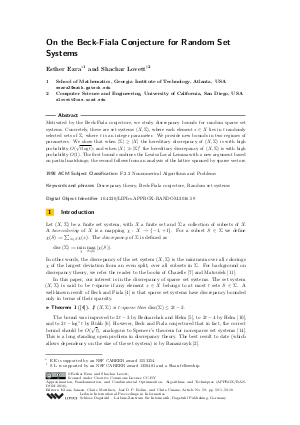On the Beck-Fiala Conjecture for Random Set Systems
Authors Esther Ezra, Shachar Lovett
-
Part of:
Volume:
Approximation, Randomization, and Combinatorial Optimization. Algorithms and Techniques (APPROX/RANDOM 2016)
Part of: Series: Leibniz International Proceedings in Informatics (LIPIcs)
Part of: Conference: International Conference on Randomization and Computation (RANDOM)
Part of: Conference: International Conference on Approximation Algorithms for Combinatorial Optimization Problems (APPROX) - License:
 Creative Commons Attribution 3.0 Unported license
Creative Commons Attribution 3.0 Unported license
- Publication Date: 2016-09-06
File

PDF
LIPIcs.APPROX-RANDOM.2016.29.pdf
- Filesize: 458 kB
- 10 pages
Document Identifiers
Subject Classification
Keywords
- Discrepancy theory
- Beck-Fiala conjecture
- Random set systems
Metrics
- Access Statistics
-
Total Accesses (updated on a weekly basis)
0Document
0Metadata
Abstract
Motivated by the Beck-Fiala conjecture, we study discrepancy bounds for random sparse set systems. Concretely, these are set systems (X,Sigma), where each element x in X lies in t randomly selected sets of Sigma, where t is an integer parameter. We provide new bounds in two regimes of parameters. We show that when |\Sigma| >= |X| the hereditary discrepancy of (X,Sigma) is with high probability O(sqrt{t log t}); and when |X| >> |\Sigma|^t the hereditary discrepancy of (X,Sigma) is with high probability O(1). The first bound combines the Lovasz Local Lemma with a new argument based on partial matchings; the second follows from an analysis of the lattice spanned by sparse vectors.
Cite As Get BibTex
Esther Ezra and Shachar Lovett. On the Beck-Fiala Conjecture for Random Set Systems. In Approximation, Randomization, and Combinatorial Optimization. Algorithms and Techniques (APPROX/RANDOM 2016). Leibniz International Proceedings in Informatics (LIPIcs), Volume 60, pp. 29:1-29:10, Schloss Dagstuhl – Leibniz-Zentrum für Informatik (2016)
https://doi.org/10.4230/LIPIcs.APPROX-RANDOM.2016.29
BibTex
@InProceedings{ezra_et_al:LIPIcs.APPROX-RANDOM.2016.29,
author = {Ezra, Esther and Lovett, Shachar},
title = {{On the Beck-Fiala Conjecture for Random Set Systems}},
booktitle = {Approximation, Randomization, and Combinatorial Optimization. Algorithms and Techniques (APPROX/RANDOM 2016)},
pages = {29:1--29:10},
series = {Leibniz International Proceedings in Informatics (LIPIcs)},
ISBN = {978-3-95977-018-7},
ISSN = {1868-8969},
year = {2016},
volume = {60},
editor = {Jansen, Klaus and Mathieu, Claire and Rolim, Jos\'{e} D. P. and Umans, Chris},
publisher = {Schloss Dagstuhl -- Leibniz-Zentrum f{\"u}r Informatik},
address = {Dagstuhl, Germany},
URL = {https://drops.dagstuhl.de/entities/document/10.4230/LIPIcs.APPROX-RANDOM.2016.29},
URN = {urn:nbn:de:0030-drops-66526},
doi = {10.4230/LIPIcs.APPROX-RANDOM.2016.29},
annote = {Keywords: Discrepancy theory, Beck-Fiala conjecture, Random set systems}
}
Author Details
References
-
Noga Alon and Joel H. Spencer. The probabilistic method. Wiley-Interscience series in discrete mathematics and optimization. Wiley, New York, Chichester, Weinheim, 2000.

-
Wojciech Banaszczyk. Balancing vectors and Gaussian measures of n-dimensional convex bodies. Random Structures &Algorithms, 12(4):351-360, 1998.

-
Nikhil Bansal, Daniel Dadush, and Shashwat Garg. An algorithm for Komlós conjecture matching Banaszczyk’s bound. arXiv preprint arXiv:1605.02882, 2016.

-
József Beck and Tibor Fiala. Integer-making theorems. Discrete Applied Mathematics, 3(1):1-8, 1981.

-
Debe Bednarchak and Martin Helm. A note on the Beck-Fiala theorem. Combinatorica, 17(1):147-149, 1997.

-
Boris Bukh. An improvement of the Beck-Fiala theorem. arXiv preprint arXiv:1306.6081, 2013.

-
Bernard Chazelle. The discrepancy method: randomness and complexity. Cambridge University Press, Cambridge, New York, 2000.

-
Paul Erdös and Rényi Alfréd. On a classical problem of probability theory. Magyar Tudományos Akadémia Matematikai Kutató Intézetének Közleményei, 6:215-220, 1961.

-
Paul Erdös and Laszlo Lovász. Problems and results on 3-chromatic hypergraphs and some related questions. Infinite and Finite Sets (to Paul Erdös on his 60th birthday), II:609-627, 1975.

-
Martin Helm. On the Beck-Fiala theorem. Discrete mathematics, 207(1):73-87, 1999.

-
Jiri Matoušek. Geometric discrepancy: An illustrated guide, volume 18. Springer Science &Business Media, 2009.

-
Robin A Moser. A constructive proof of the Lovász local lemma. In Proceedings of the forty-first annual ACM symposium on Theory of computing, pages 343-350. ACM, 2009.

-
Robin A Moser and Gábor Tardos. A constructive proof of the general Lovász local lemma. Journal of the ACM (JACM), 57(2):11, 2010.

-
Joel Spencer. Six standard deviations suffice. Transactions of the American Mathematical Society, 289(2):679-706, 1985.

-
Richard M. Wilson. A diagonal form for the incidence matrices of t-subsets vs. k-subsets. European Journal of Combinatorics, 11(6):609-615, 1990.

